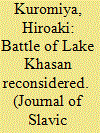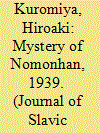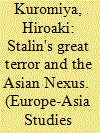| Srl | Item |
| 1 |
ID:
090850


|
|
|
|
|
| Publication |
2009.
|
| Summary/Abstract |
This article examines the little known history of political collaboration between Caucasian national groups and Japan directed against the Soviet Union in the 1930s. The collaboration, begun at the time of the 1904-1905 Russo-Japanese War, resumed in the 1920s and continued through World War II. The Caucasian groups (Haidar Bammat's 'Caucasus Group' in particular) and Japan worked together to pursue their common goal of dismembering the Soviet Union. Their anti-Soviet subversion was real yet achieved few results in the face of extraordinary Soviet security. Nevertheless, Stalin took no chances and terrorised anyone suspected of any possible link to the subversive activity.
|
|
|
|
|
|
|
|
|
|
|
|
|
|
|
|
| 2 |
ID:
148389


|
|
|
|
|
| Summary/Abstract |
Almost all history books claim that the Battle of Lake Khasan was provoked in the summer of 1938 by the aggression of Imperial Japan into Soviet territory. The Tokyo War Crimes Tribunal of 1946 accepted this version propagated by Moscow, which almost all historians have also accepted. There has been no substantive re-examination of this battle for more than three quarters of a century. Recent publications from Soviet military archives as well as documents from the Dmitrii Volkogonov Archive suggest that the Soviet-Japanese military conflict of 1938 was a cleverly disguised Soviet provocation. This fundamental reassessment of the battle has far-reaching implications for Moscow’s war of camouflage, disinformation, and obfuscation during the Soviet and post-Soviet era.
|
|
|
|
|
|
|
|
|
|
|
|
|
|
|
|
| 3 |
ID:
124569


|
|
|
|
|
| Publication |
2013.
|
| Summary/Abstract |
Japan's diplomatic codes were broken by the Soviet Union in the late 1930s. This was due to Kozo Izumi (1890-1956), a Japanese diplomat and Soviet specialist stationed in Eastern Europe, who provided Japan's code books and keys to the Soviet secret police. Married to a Muscovite of noble origin working for the Soviet Foreign Intelligence, Izumi was entrapped and ultimately chose love over country. He thus led an unwitting Japan to conduct 'open diplomacy' towards the Soviet Union.
|
|
|
|
|
|
|
|
|
|
|
|
|
|
|
|
| 4 |
ID:
109103


|
|
|
|
|
| Publication |
2011.
|
| Summary/Abstract |
The Battle of Nomonhan ended decisively in favor of the Soviet Red Army. Yet why it turned out so has not always been clearly understood. In fact, there are other mysteries about Nomonhan: why small skirmishes turned into a major battle, why the command of the Japanese troops (especially its core force, the 23rd Division) was so poor, why the Division Commander Michitaro Komatsubara behaved so peculiarly throughout the battle and after. The present essay suggests that Komatsubara's treachery provides an explanation to these mysteries; he appears to have been a Soviet agent.
|
|
|
|
|
|
|
|
|
|
|
|
|
|
|
|
| 5 |
ID:
105241


|
|
|
|
|
| Publication |
2011.
|
| Summary/Abstract |
No political leader lives without espionage. While astute political leaders know well the traps inherent in the mutual deception game of espionage, Stalin's Great Terror of 1937-38 illustrates the extraordinary reach of espionage. In this particular case, Stalin set traps for the world in order to prepare for a forthcoming showdown with his mortal enemies, Germany in particular. He took nearly a million lives of men and women of his own country in the process. Although the Terror still remains an enigma, it appears that Stalin's traps still ensnare people. This offers lessons to be learned about politics in general.
|
|
|
|
|
|
|
|
|
|
|
|
|
|
|
|
| 6 |
ID:
131788


|
|
|
|
|
| Publication |
2014.
|
| Summary/Abstract |
Stalin's Great Terror of 1937-1938 did not stop at the Soviet borders: under Moscow's explicit instructions, it extended to Asia, particularly to the People's Republic of Mongolia and to Xinjiang or Chinese Turkestan. More people proportionately suffered from the Terror in Mongolia than in the Soviet Union. Stalin's terror operations in the Asiatic lands were implicitly directed against Japan, the main competitor for influence in the region.
|
|
|
|
|
|
|
|
|
|
|
|
|
|
|
|